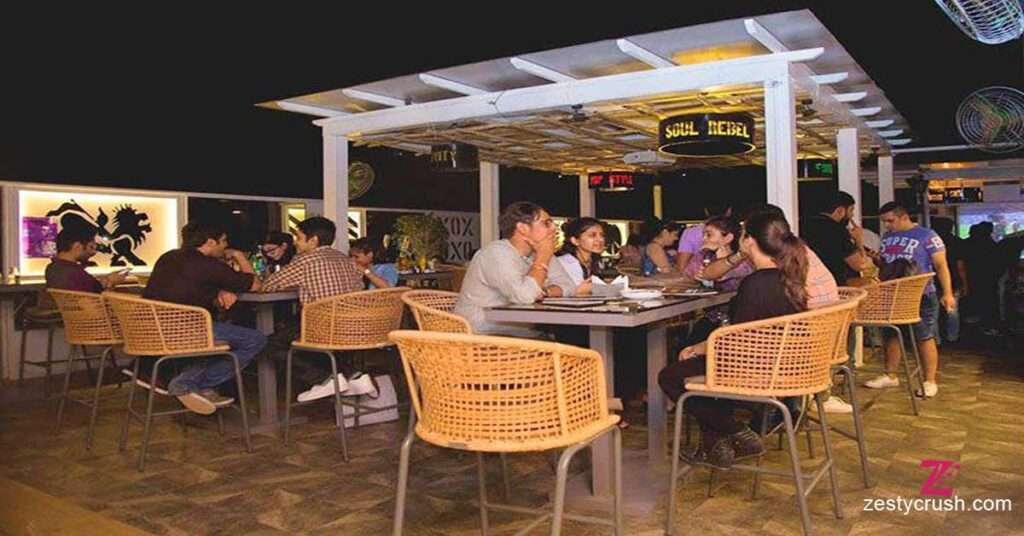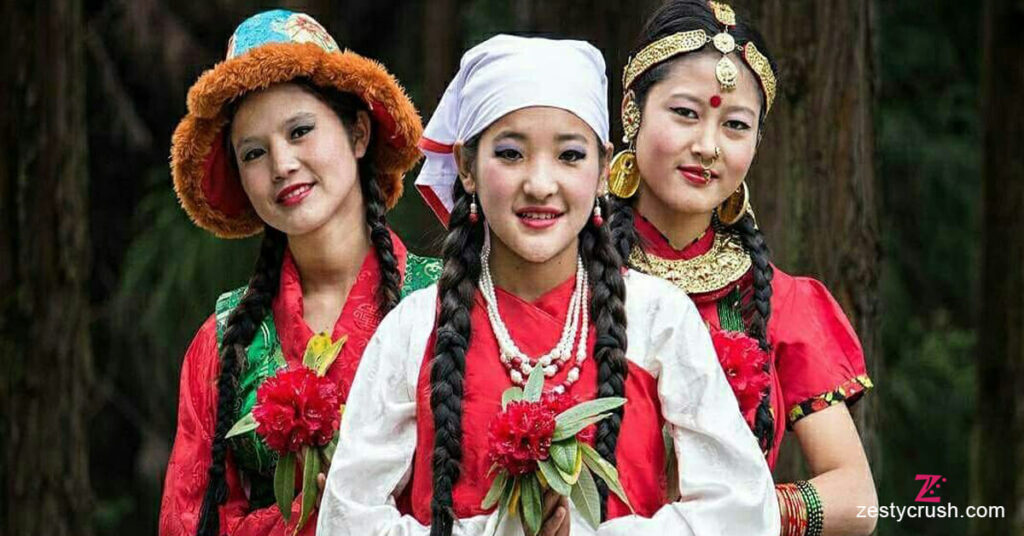Nagaland Traditional Dress- Culture, Color, and Craft
Nagaland is a land of rich culture and traditions situated in the northeastern part of India. Nagaland culture is vibrant and colorful like its beautiful landscapes. It has a home of sixteen major tribes each with its unique customs, language and traditional attire. The Nagaland traditional dress is more than just clothing; it’s a symbol of identity, pride, and history. In this article, we will explore the beautiful and diverse traditional dress of Nagaland, covering the attire worn by men and women, bridal and groom attire, and the essential accessories that make Naga fashion distinct.
Nagaland’s traditional attire is a bright representation of the state’s culture, diversity, and skillful craftsmanship. Each of Nagaland’s tribes wears distinctive clothing embellished with symbolic colors, elaborate weaves, and handcrafted accessories that reflect its culture and history. Traditional clothing frequently comprise shawls, skirts, and headgear, with each pattern telling a story about the tribe’s history. The warrior shawls, vivid beading, and feathered headpieces are more than just clothes; they are proud emblems of Naga traditions and artistry, expressing strength, honor, and solidarity. This blend of color, culture, and craft preserves and celebrates Nagaland’s unique history.
The Diversity of Nagaland Traditional Dress
Nagaland traditional dress is a symbol of its various tribal heritage. State’s each tribe can be identified by its unique dressing style which highlights their status and customs. The tribe’s identity can be visually identified through the window of their dress variations in patterns, color, and accessories. The traditional dress of Nagaland is deeply rooted pride in their heritage not only in the local lifestyle. The clothes are adorned with intricate designs making each outfit a piece of art these designs also signify the wearer’s status, achievements and the tribe they belong to.
Nagaland Traditional Dress Male
The Nagaland traditional dress is practical and symbolic. It often consists of garments that imitate the tribe’s specific history and are comfortable for the region terrain. Shawls, loincloths and unique waist belts which vary between tribes are the men’s traditional clothing in Nagaland.
Naga men’s dress integral part is the shawl which often worn as a status symbol. It indicates the marital status, individual’s achievements, and tribe they belong to. Men who have accomplished specific feats or have a particular status in the community certain patterns and colors are reserved for them. The men’s traditional dress, with its unique identifiers making each tribe version of dress different but it is largely similar across tribes.
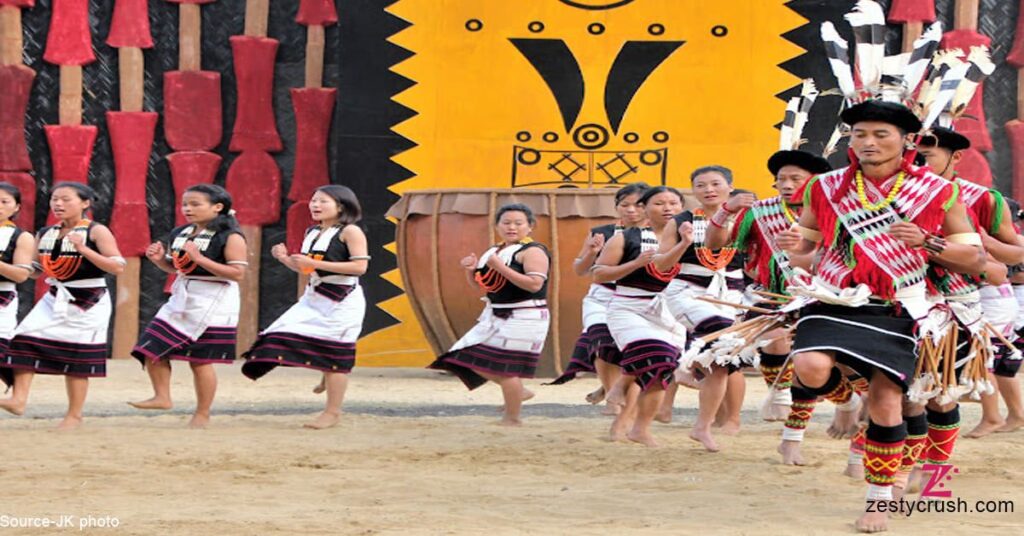
Shawls and Their Importance
Naga men’s iconic piece of attire is shawl. The shawls representing everything from the wearer’s age to his status in the tribe from its design. For example, the Sumi Naga shawl known for its bold red and black stripes shows valor and strength. The Ao Naga tribe’s shawl the “Tsungkotepsu,” features geometric patterns and symbols that tell stories of bravery and history.
Nagaland Traditional Dress Female
Women’s traditional dress in Nagaland is having its different style with each tribe and is as colorful and diverse as the men’s. The dress for women typically includes a combination of skirts, blouses, and wraps, decorated with exciting colors and patterns these are the Naga traditional dress fashion in present time. Naga women creativity and skill can be seen on women garment which is precisely crafted. Mekhalas a traditional Naga skirts and Nagaland costume come in bold and striking colors with complex patterns that portray the wearer’s tribe.
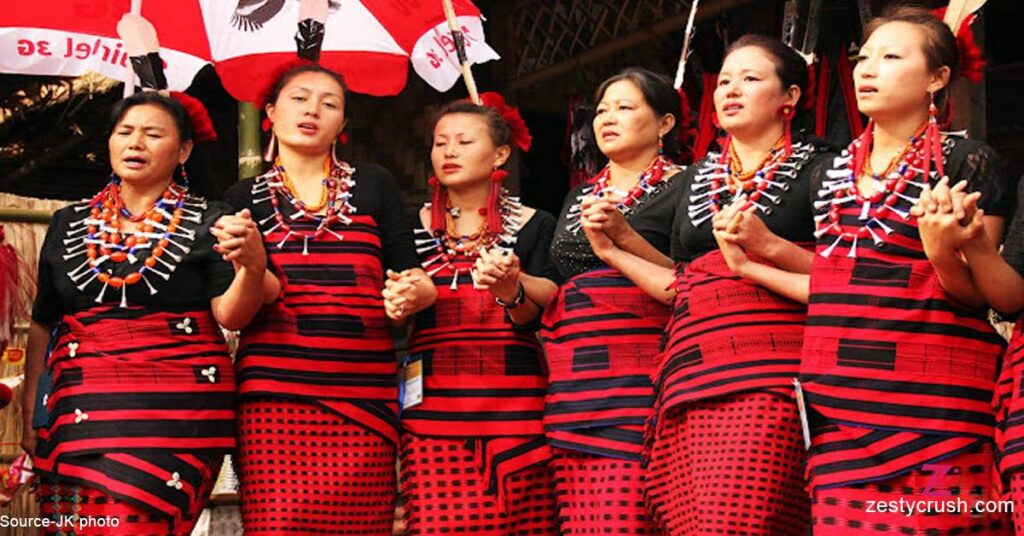
Traditional Skirts and Blouses
Naga women wear skirts dyed in bright colors like red, blue, and black which made from thick fabric and hand woven. The Naga costumes are simple yet elegant blouses wrapped around the upper body are often paired with this skirt. For example, the Ao women prefer skits with broad striped and typical borders while the Santam women use skirts with delicate embroidery that shows their rich heritage.
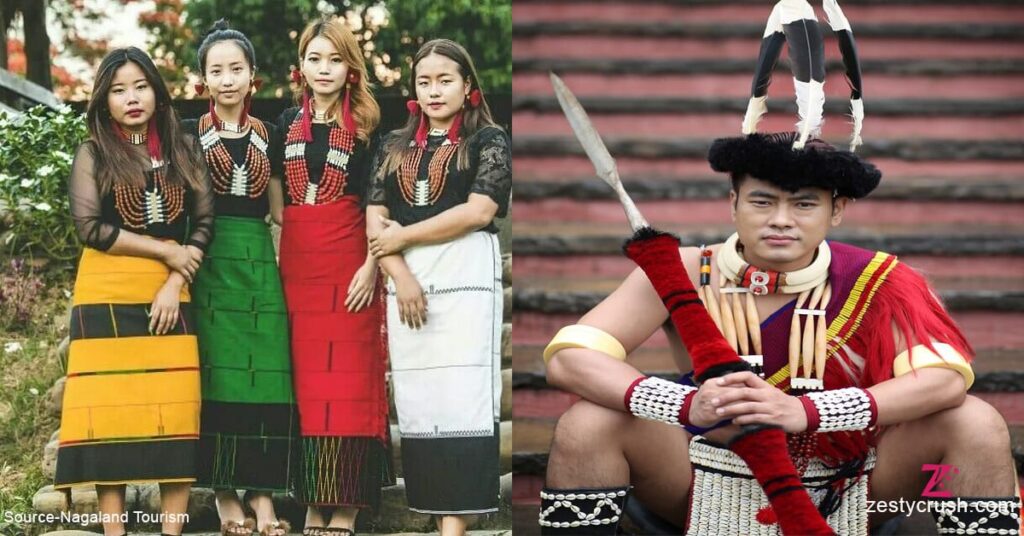
Nagaland Traditional Dress- Naga Bride Dresses
Bridal attire in Nagaland stands out during weddings it is full of vibrant colors, elaborate jewelry, and traditional patterns that sight to behold. A Naga bride’s dress just not reflect her family’s heritage but also chosen carefully to enhance their beauty. The wedding dress is a combination of traditional skirts, rich shawls, and elaborate jewelry. Symbolizing prosperity, joy and cultural heritage bright colors like red, green, and blue dominate bridal attire. Jewelry like necklaces plays an important role in completing the bride’s jewelry set made from traditional beads and shells.
Nagaland Traditional Dress-Naga Groom Dresses
Just like the brides Naga grooms also wear attire which shows Nagaland dressing style that is both symbolic and traditional. The groom’s outfit is designed to display his masculinity status and readiness for the responsibilities that come with marriage. Grooms usually wear knottily designed shawls loincloths and headgear all these are Nagaland culture dress that represent their tribal lineage. Certain patterns and colors are specifically reserved for weddings showcasing the uniqueness of the occasion. The groom’s attire is often complemented by accessories like a ceremonial spear or a traditional sword symbolizing strength and protection.
Nagaland Traditional Dress- Traditional Items for Males
Various accessories that symbolize tribal heritage are used in tradition Naga attire for men. They are statement of the wearer’s role and status within the tribe and not only decorative items. Men’s attire commonly consist Spears, Daos (traditional knives) and decorative belts. Traditional headgear is another notable accessory decorated with feathers, beads and animal motifs indicating the wearer’s rank or achievement.
Nagaland Traditional Dress-Traditional Items for Females
For women, traditional accessories hold significant meaning and add beauty to their attire. Beaded necklaces, heavy metal bangles, and anklets are commonly worn, each carrying a story or cultural importance. Women’s jewelry is not merely decorative but is an expression of tribal identity and femininity. It often involves detailed craftsmanship, with natural elements like stones, shells, and metals being favored for their cultural symbolism.
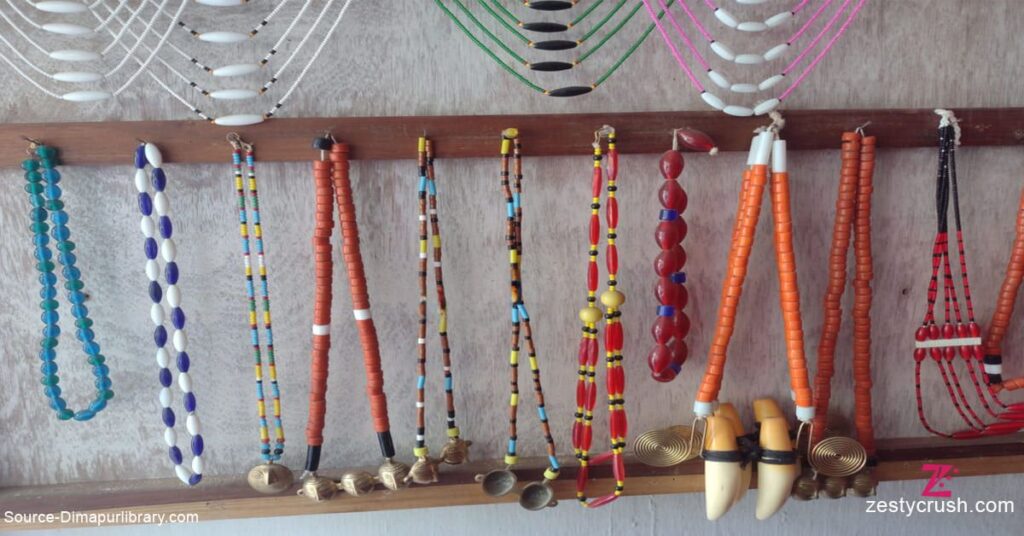
Jewelry: A Significant Part of Naga Women’s Attire
Jewelry is a vital part of traditional Naga attire, especially for women. The intricate designs and bold materials used in Naga jewelry set them apart. Necklaces are often made from beads, shells, and bones, while bracelets and anklets are crafted from metal and wood, symbolizing the tribe’s closeness to nature.
Necklaces and Their Meanings
Necklaces signify the wearer’s marital status social standing and sometimes even her role within the tribe. For example, the heavy stone bead necklaces worn by Konyak women indicate their prestigious status in the tribe while the delicate beadwork seen in Ao women’s jewelry reflects a blend of tradition and elegance.
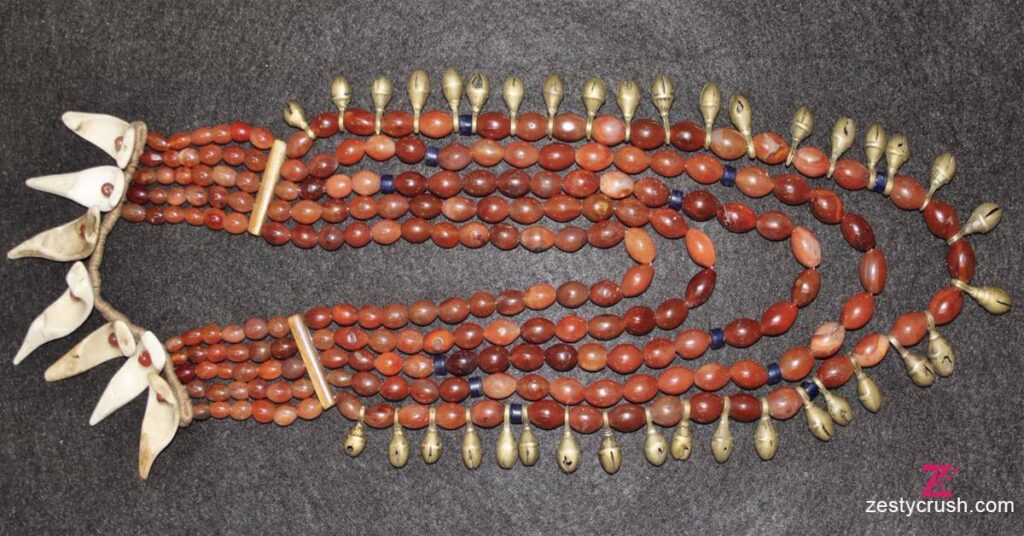
Unique Features of Nagaland’s Traditional Attire
The use of bright and contrasting colors is unique feature of Naga attire. These colors are chosen for aesthetics and for their cultural importance. For example, red always represents bravery and courage and black can represents strength and power.
The patterns woven into the fabric are geometric and carry stories or symbols important to the tribe. Use of natural materials is another striking feature like cane, bamboo and shells which are always incorporated into garments and accessories both.
The Headgear of Nagaland
Each tribe having its unique style of traditional headgear holds a place of pride in Naga culture. For example, the Konyak Naga are well known for their headgears decorated with boar’s tusks and dyed feathers. During festivals and ceremonies this type of headgear is always worn representing power and the tribe’s warrior heritage. On the other hand, the Ao tribe’s headgear features bright feathers and beads showing beauty and craftmanship. These traditions are repeatedly passed down through generations carrying historical and familial importance.
Nagaland Dress Code
Traditional dress in Nagaland isn’t only worn for aesthetics—it follows a cultural code that signifies respect, honor, and adherence to tradition. Different occasions require different attire, and the dress code varies according to the festival, ceremony, or daily activity.
For instance, during festivals like the Hornbill Festival, the most elaborate and traditional outfits are worn which is the Nagaland dress code to celebrate and showcase cultural pride. For displaying the uniqueness of their heritage each tribe dresses in their finest form. Traditional attire tends to be simpler yet still hold cultural importance in everyday wear. To serve as markers of age, status and occasion use of specific colors, pattern and accessories norms are delicate in clothing.
Famous Traditional Dresses from Specific Naga Tribes
Nagaland is home to several tribes, each with its own distinct style of traditional dress. The diversity in their attire adds to the rich cultural tapestry of the region. Here’s a closer look at some of the most prominent tribes and their unique traditional attire:
Konyak Traditional Attire
The Konyak have some of the most visually striking Naga traditional attire known as fierce warriors. Heavy brass ornaments, earring made from animal bones, and headgear with hornbill feathers are worn by Konyak men. Their shawls are marked with typical red, black and white patterns which narrate tales of valor. Konyak tribe women wear shawls and skirts with colorful embroidery and accessorize with bold jewelry.
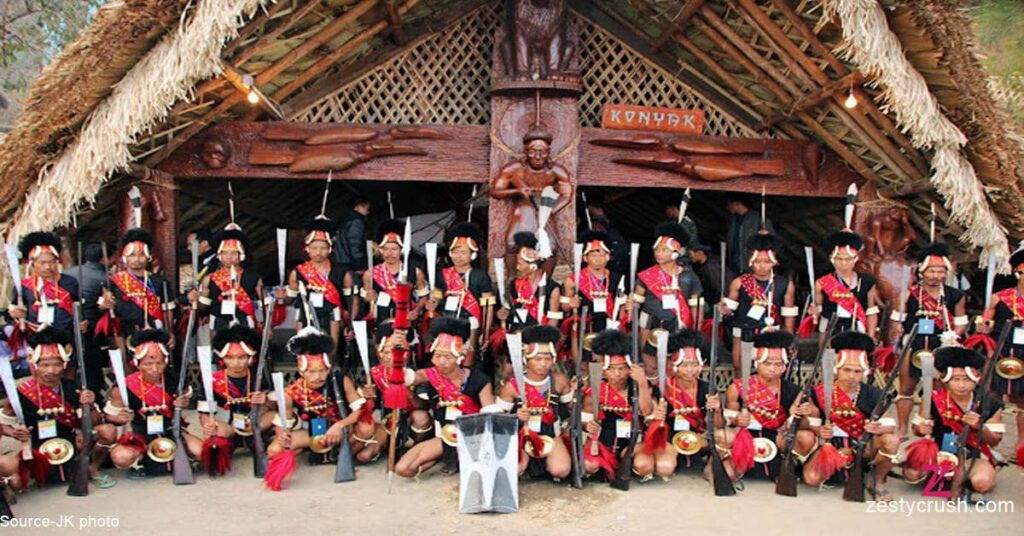
Sumi Traditional Dress
The Sumi tribe’s traditional dress is categorized by vibrant and bold patterns, always featuring red and black stripes. The Sumi men wear a special shawl known as “Akemhei,” which denotes a man’s status and achievements. The women wear skirts that are rich in colors, showing the tribe’s joyous and lively nature. Beaded jewelry, made from shells and seeds, is an essential part of Sumi women’s attire, showing their expertise.
Ao Naga Traditional Dress
Tsungkotepsu, is the characteristic shawl of of Naga Traditional Dress of Ao tribe. This shawl (Nagaland Clothes) pattern is always black with bold red and white patterns, representing bravery and status. Mekhala, is a handwoven skirt with symbolic design is the women’s traditional dress paired with a plain blouse. The beads in jewelry are remarkably used by the Ao tribe’s as each necklace always has a story or cultural importance.
Conclusion
Nagaland’s traditional dress is a celebration of culture, identity, and history. Each piece from the exciting shawls of the Konyak tribe to the beaded jewelry of the Ao tribe tells a unique story about the people and their way of life. This exploration into the traditional dress of Nagaland shows the beauty and diversity of the state’s cultural heritage which is lovingly preserved through generations. Appreciating the traditional dress of Nagaland is a gateway into the soul of this fascinating state whether you are planning a visit to Nagaland or simply interested in its culture. These unique garments represent the pride and history of Nagaland’s many tribes hence respect and admiration for these unique garments are essential.
FAQ
What is the traditional dress of Nagaland called?
The traditional dress of Nagaland varies by tribe, but generally, men’s attire includes shawls and loincloths, while women’s attire features skirts called mekhalas and matching blouses. The dress names also vary based on the specific tribe, such as the Tsungkotepsu shawl for the Ao tribe or the Akemhei shawl for the Sumi.
What are some popular tribal dresses in Nagaland?
Some of the most popular tribal dresses include the Konyak shawl, the Ao Tsungkotepsu, the Sumi Akemhei, and the brightly patterned skirts of the Angami and Chakhesang tribes. Each tribal dress has unique elements and colors that signify their heritage.
How is jewelry important in Naga traditional attire?
Jewelry plays a significant role in Naga attire, especially for women. It represents social status, marital status, and tribal identity. Traditional jewelry is often made from natural materials like beads, shells, bones, and metals, with intricate designs that reflect the wearer’s culture.
What do the patterns on Naga shawls signify?
The patterns on Naga shawls are deeply symbolic, often indicating the wearer’s tribe, social status, and accomplishments. Some designs are reserved for elders or warriors, while others are for everyday use. The colors and motifs can tell stories of bravery, peace, or historical events.
What makes a Naga wedding dress unique?
A Naga wedding dress is unique due to its vibrant colors, traditional patterns, and heavy use of jewelry. Brides often wear richly embroidered skirts, shawls, and blouses, paired with bold necklaces, bracelets, and earrings. The wedding attire reflects joy, prosperity, and the merging of two families.
Can traditional Naga dress be worn by non-Nagas?
Yes, traditional Naga dress can be worn by non-Nagas, especially during festivals like the Hornbill Festival, where visitors are encouraged to appreciate and partake in local culture. However, it’s important to wear these garments with respect and understand their cultural significance.
Which tribe in Nagaland has the most distinct clothing?
Every tribe in Nagaland has distinct clothing, but the Konyak and Ao tribes are often noted for their unique attire. The Konyak’s elaborate headdresses and the Ao’s bold, symbolic shawls stand out as some of the most visually distinct styles among the tribes.



